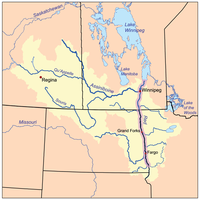Red River Valley
| Part ofa serieson the |
| Red River of the North |
|---|
 |
| Major Floods |
| Geology |
| Infrastructure |
| Related Topics |
TheRed River Valleyis a region in centralNorth Americathat is drained by theRed River of the North;it is part of both Canada and the United States. Forming the border betweenMinnesotaandNorth Dakotawhen these territories were admitted as states in the United States, this fertile valley has been important to the economies of these states and toManitoba,Canada.
The population centers ofMoorhead, Minnesota,FargoandGrand Forks, North Dakota,andWinnipeg, Manitobadeveloped in the valley as settlement by ethnic Europeans increased in the late nineteenth century. Completion of major railroads, availability of cheap lands, and forceful removal of Indigenous people as well as a subsequent refusal to recognize Indigenous land claims attracted many new settlers. Some developed large-scale agricultural operations known asbonanza farms,which concentrated on wheat commodity crops.
PaleogeographicLake Agassizlaid down the Red River Valley Silts. The valley was long an area of habitation by variousindigenouscultures, including the historicOjibweandMétispeoples. The river flows north through a wide ancient lake plain toLake Winnipeg.The geography and seasonal conditions can produce devastating floods, with several recorded since the mid-20th century.
Early European settlement[edit]
Frenchfur tradershad relations with First Nations and Native Americans throughout the Great Lakes region. They often lived with the tribes and married or had relations with native women. By the mid-17th century, theMétis,descendants of these Frenchmen andCreetribes people (in addition to other First Nations peoples), settled in the Red River valley.[1]The Métis established anethnicityand culture, as many continued a tradition as hunters and traders involved in the fur trade. They were also farmers in this area.
The British took over French territory east of the Mississippi River following its victory in theSeven Years' War.In the early 19th century, the lucrative fur trade attracted continuing interest, andLord Selkirkestablished theRed River Colony.[2]In 1803 the United States acquired former French territory west of the Mississippi River in theLouisiana Purchasefrom France. This included some of the Red River Valley.
U.S. geographical importance[edit]

The U.S. government uses the termRed River Valleygenerally to describe the sections of northwestern Minnesota and eastern North Dakota to which it secured title following theAnglo-American Convention of 1818that settled the northern boundary of the US and Canada.[3]
This land became part as the second article of the 1818 treaty declared the49th parallelto be the official border between the U.S. andCanadaup to theRocky Mountains.(This borderline was extended to thePacific Oceanin 1846 under theOregon Treaty.) The land acquired under the treaty had an area of 29,066,880 acres (117,629.5 km2), comprising 1.3 percent of total U.S. land area. Centered on theRed River of the North,these lands had previously been under the control ofGreat Britain.[4]
West of the Red River Valley, the territory of theLouisiana Purchase,which the US acquired from France, extends north of the 49th parallel. The US ceded this to Britain in exchange for gaining the Red River Valley. These northernmost parts of the Louisiana Purchase are one of the few North American territories ever ceded by the United States to a foreign power.[5]
Prone to flooding[edit]
The four factors make the Red River Valley so prone to flooding (the factors are related tophysical geography):
Synchrony of Discharge with Spring Thaw:The Red River flows northward. The spring thaw also proceeds gradually northward. As a result, runoff from the southern portion of the valley gradually joins the fresh melt-off waters from northerly areas along the Red River. In the northern part of the Valley, this can result in devastating floods if the effects occur at the same time.
Ice Jams:These are also produced because of the northward-flowing river system. Ice is moving from the southern Valley and freshly-broken ice is moving from the central and northern Valley. These two meet steadily; as a result, ice concentration in this system builds and causes delay of water flow.
Glacial Lake Plain:The floor of Glacial Lake Agassiz is one of the flattest expanses of land in the world. Here, the Red River has cut a shallow, winding valley. As a result of this, when the river floods on this plain, a devastating event can occur. The areal coverage of the waters can become dramatic. Being approximately 9,300 years old, the Red River has not yet carved a large valley-floodplain systems on the surrounding geography. Thus, the large lake plain becomes the floodplain to the Red River. The Lake Agassiz glacial lake plain extends around 100 miles from east to west, end to end, between northeastern North Dakota and northwestern Minnesota.
Decrease in Gradient Downstream:The gradient, or slope, of the Red River averages 5 inches per mile of length. In the region of Drayton-Pembina, the gradient is only 1.5 inches per mile. The water tends to pool in this area during flood season. The region can become a massive, shallow lake.[6]
See also[edit]
Notes[edit]
- ^Risjord, Norman K. (2005).A Popular History of Minnesota.Saint Paul, MN: Minnesota Historical Society Press. p. 41.ISBN0-87351-532-3.
- ^Ross, Alexander (1856).The Red River Settlement: Its Rise, Progress, and Present State.Smith, Elder and Company.RetrievedOctober 26,2015.
- ^"The Convention of 1818 and the 49th Parallel: Background History for Kids".September 2015.RetrievedOctober 26,2015.
- ^"Acquisition of the Public Domain, 1781–1867: Table 1-1"(PDF).U.S. Department of the Interior: Bureau of Land Management. 2011. p. 3. Archived fromthe original(PDF)on February 19, 2017.RetrievedOctober 26,2015.
- ^McMullin, Kevin D. (April 16, 2011)."The Treaty of 1818".Wordpress.RetrievedOctober 26,2015.
- ^Schwert, Donald."Why is the Red River of the North so vulnerable to flooding".Geology of the Fargo-Moorhead Region.Department of Geosciences North Dakota State University.Retrieved13 July2015.

